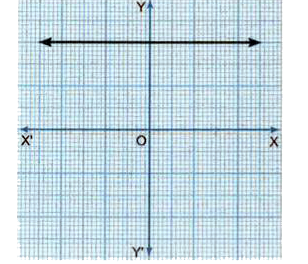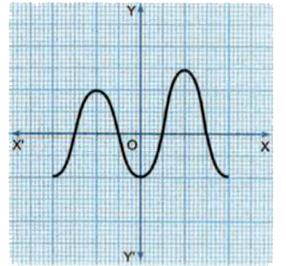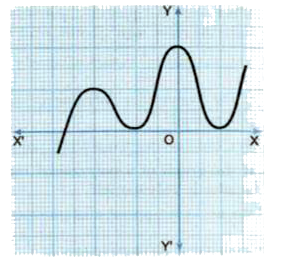Complete Solutions to VERY SHORT ANSWER QUESTIONS of chapter POLYNOMIALS of Class 10 book with complete answers and questions
| Class 10 | MATHS |
| Chapter | POLYNOMIALS |
| VK GLOBAL PUBLICATION | VERY SHORT ANSWER QUESTIONS |
| Number Of Questions | 15 |
| Academic Year | 2023-24 |
The graphs of y = p(x) for some polynomials are given below. Find the number of zeros in each case.

View SolutionThe graphs of y = p(x) for some polynomials are given below. Find the number of zeros in each case.

View SolutionThe graphs of y = p(x) for some polynomials are given below. Find the number of zeros in each case.

View SolutionThe graphs of y = p(x) for some polynomials are given below. Find the number of zeros in each case.

View SolutionWhat will the quotient and remainder be on division of `ax^(2) + bx + c` by `px^(5) + rx + 5, p ne 0`
View SolutionIf on division of a polynomial p(x) by a polynomial g(x), the quotient is zero, what is the relation between the degrees of p(x) and g(x)?
View SolutionCan `(x - 2)` be the remainder on division of a polynomial p(x) by `(x + 3)`?
View SolutionFind the quadratic polynomial whose zeros are 3 and 4.
View SolutionIf one zero of the quadratic polynomial `x^2 - 5x - 6` is 6 then find the other zero
View SolutionIf both the zeros of the quadratic polynomial `ax^2 + bx + c` are equal and opposite in sign, then find the value of b.
View SolutionWhat should be added to the polynomial `x^2-5x+4` , so that 3 is the zero of the resulting polynomial? (a) `1` (b) `2` (c) `4` (d) `5`
View SolutionCan a quadratic polynomial `x^2 + kx + k` have equal zeros for some odd integer `k gt 1`?
View SolutionAre the following statements 'True' or 'False'? Justify your answer.
(i) If the zeroes of a quadratic polynomial `ax^(2) +bx +c` are both positive, then a,b and c all have the same sign.
(ii) If the graph of a polynomial intersects the X-axis at only one point, it cannot be a quadratic polynomial.
(iii) If the graph of a polynomial intersects the X-axis at exactly two points, it need not ve a quadratic polynomial.
(iv) If two of the zeroes of a cubic polynomial are zero, then it does not have linear and constant terms.
(v) If all the zeroes of a cubic polynomial are negative, then all the coefficients and the constant term of the polynomial have the same sign.
(vi) If all three zeroes of a cubic polynomial `x^(3) +ax^(2) - bx +c` are positive, then atleast one of a,b and c is non-negative.
(vii) The only value of k for which the quadratic polynomial `kx^(2) +x +k` has equal zeroes is `(1)/(2)`.
View SolutionAre the following statements 'True' or 'False'? Justify your answer.
(i) If the zeroes of a quadratic polynomial `ax^(2) +bx +c` are both positive, then a,b and c all have the same sign.
(ii) If the graph of a polynomial intersects the X-axis at only one point, it cannot be a quadratic polynomial.
(iii) If the graph of a polynomial intersects the X-axis at exactly two points, it need not ve a quadratic polynomial.
(iv) If two of the zeroes of a cubic polynomial are zero, then it does not have linear and constant terms.
(v) If all the zeroes of a cubic polynomial are negative, then all the coefficients and the constant term of the polynomial have the same sign.
(vi) If all three zeroes of a cubic polynomial `x^(3) +ax^(2) - bx +c` are positive, then atleast one of a,b and c is non-negative.
(vii) The only value of k for which the quadratic polynomial `kx^(2) +x +k` has equal zeroes is `(1)/(2)`.
View SolutionAre the following statements 'True' or 'False'? Justify your answer.
(i) If the zeroes of a quadratic polynomial `ax^(2) +bx +c` are both positive, then a,b and c all have the same sign.
(ii) If the graph of a polynomial intersects the X-axis at only one point, it cannot be a quadratic polynomial.
(iii) If the graph of a polynomial intersects the X-axis at exactly two points, it need not ve a quadratic polynomial.
(iv) If two of the zeroes of a cubic polynomial are zero, then it does not have linear and constant terms.
(v) If all the zeroes of a cubic polynomial are negative, then all the coefficients and the constant term of the polynomial have the same sign.
(vi) If all three zeroes of a cubic polynomial `x^(3) +ax^(2) - bx +c` are positive, then atleast one of a,b and c is non-negative.
(vii) The only value of k for which the quadratic polynomial `kx^(2) +x +k` has equal zeroes is `(1)/(2)`.
View Solution
VERY SHORT ANSWER QUESTIONS questions and complete solutions for chapter POLYNOMIALS of VK GLOBAL PUBLICATION MATHS (HINGLISH) of Class 10
All Exercises from VK GLOBAL PUBLICATION Class 10 MATHS POLYNOMIALS
- HOTS (HIGHER ORDER THINKING SKILLS)
- LONG ANSWER QUESTIONS 4 marks
- PROFICIENCY EXERCISE (LONG ANSWER QUESTIONS)
- PROFICIENCY EXERCISE (SHORT ANSWER QUESTIONS-I)
- PROFICIENCY EXERCISE (SHORT ANSWER QUESTIONS-II)
- PROFICIENCY EXERCISE (VERY SHORT ANSWER QUESTIONS)
- SELF-ASSESSMENT TEST
- SHORT ANSWER QUESTIONS-I
- SHORT ANSWER QUESTIONS-II
- VERY SHORT ANSWER QUESTIONS